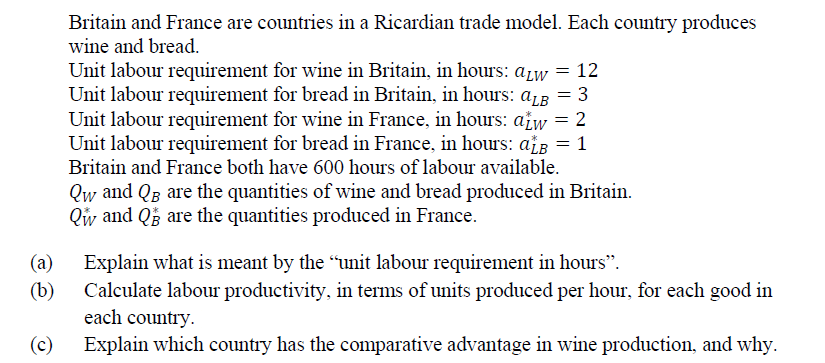Britain and France are countries in a Ricardian trade model. Each country produces wine and bread. Unit labour requirement for wine in Britain, in hours: azw = 12 Unit labour requirement for bread in Britain, in hours: aLB = 3 Unit labour requirement for wine in France, in hours: alw = 2 Unit labour requirement for bread in France, in hours: aÏB = 1 Britain and France both have 600 hours of labour available.
Britain and France are countries in a Ricardian trade model. Each country produces wine and bread. Unit labour requirement for wine in Britain, in hours: azw = 12 Unit labour requirement for bread in Britain, in hours: aLB = 3 Unit labour requirement for wine in France, in hours: alw = 2 Unit labour requirement for bread in France, in hours: aÏB = 1 Britain and France both have 600 hours of labour available.
Chapter1: Making Economics Decisions
Section: Chapter Questions
Problem 1QTC
Related questions
Question
Question 8
Please awnser question 8 a b and c

Transcribed Image Text:Britain and France are countries in a Ricardian trade model. Each country produces
wine and bread.
Unit labour requirement for wine in Britain, in hours: aw = 12
Unit labour requirement for bread in Britain, in hours: ALB = 3
Unit labour requirement for wine in France, in hours: atw = 2
Unit labour requirement for bread in France, in hours: aLB = 1
Britain and France both have 600 hours of labour available.
Qw and QB are the quantities of wine and bread produced in Britain.
Qw and Q are the quantities produced in France.
(a)
Explain what is meant by the “unit labour requirement in hours”.
(b)
Calculate labour productivity, in terms of units produced per hour, for each good in
each country.
(c)
Explain which country has the comparative advantage in wine production, and why.
Expert Solution
This question has been solved!
Explore an expertly crafted, step-by-step solution for a thorough understanding of key concepts.
Step by step
Solved in 3 steps

Follow-up Questions
Read through expert solutions to related follow-up questions below.
Follow-up Question
I think the solution for part c is not right. I think the answer
Can you check the answer again for me please?
Solution
Knowledge Booster
Learn more about
Need a deep-dive on the concept behind this application? Look no further. Learn more about this topic, economics and related others by exploring similar questions and additional content below.Recommended textbooks for you


Principles of Economics (12th Edition)
Economics
ISBN:
9780134078779
Author:
Karl E. Case, Ray C. Fair, Sharon E. Oster
Publisher:
PEARSON

Engineering Economy (17th Edition)
Economics
ISBN:
9780134870069
Author:
William G. Sullivan, Elin M. Wicks, C. Patrick Koelling
Publisher:
PEARSON


Principles of Economics (12th Edition)
Economics
ISBN:
9780134078779
Author:
Karl E. Case, Ray C. Fair, Sharon E. Oster
Publisher:
PEARSON

Engineering Economy (17th Edition)
Economics
ISBN:
9780134870069
Author:
William G. Sullivan, Elin M. Wicks, C. Patrick Koelling
Publisher:
PEARSON

Principles of Economics (MindTap Course List)
Economics
ISBN:
9781305585126
Author:
N. Gregory Mankiw
Publisher:
Cengage Learning

Managerial Economics: A Problem Solving Approach
Economics
ISBN:
9781337106665
Author:
Luke M. Froeb, Brian T. McCann, Michael R. Ward, Mike Shor
Publisher:
Cengage Learning

Managerial Economics & Business Strategy (Mcgraw-…
Economics
ISBN:
9781259290619
Author:
Michael Baye, Jeff Prince
Publisher:
McGraw-Hill Education